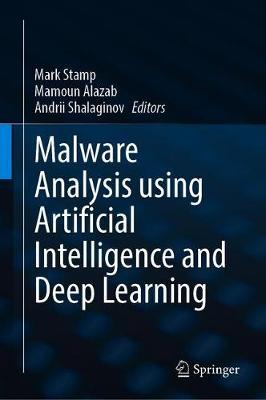图书简介
?This book is focused on the use of deep learning (DL) and artificial intelligence (AI) as tools to advance the fields of malware detection and analysis. The individual chapters of the book deal with a wide variety of state-of-the-art AI and DL techniques, which are applied to a number of challenging malware-related problems. DL and AI based approaches to malware detection and analysis are largely data driven and hence minimal expert domain knowledge of malware is needed.This book fills a gap between the emerging fields of DL/AI and malware analysis. It covers a broad range of modern and practical DL and AI techniques, including frameworks and development tools enabling the audience to innovate with cutting-edge research advancements in a multitude of malware (and closely related) use cases.
1. Optimizing Multi-class Classi?cation of Binaries Based on Static Features.-2.Detecting Abusive Comments Using Ensemble Deep Learning Algorithms.-3. Deep Learning Techniques for Behavioural Malware Analysis in Cloud IaaS.-4. Addressing Malware Attacks on Connected and Autonomous Vehicles: Recent Techniques and Challenges.-5. A Selective Survey of Deep Learning Techniques and Their Application to Malware Analysis.-6. A Comparison of Word2Vec, HMM2Vec, and PCA2Vec for Malware Classi?cation.-7. Word Embedding Techniques for Malware Evolution Detection.-8. Reanimating Historic Malware Samples.-9. DURLD: Malicious URL detection using Deep learning based Character-level representations.-10. Sentiment Analysis for Troll Detection on Weibo.-11. Beyond Labeling: Using Clustering to Build Network Behavioral Pro?les of Malware Families.-12. Review of the Malware Categorization in the Era of Changing Cybethreats Landscape: Common Approaches, Challenges and Future Needs.-13. An Empirical Analysis of Image-Based Learning Techniques for Malware Classi?cation.-14. A Survey of Intelligent Techniques for Android Malware Detection.-15. Malware Detection with Sequence-Based Machine Learning and Deep Learning.- 16. A Novel Study on Multinomial Classi?cation of x86/x64 Linux ELF Malware Types and Families through Deep Neural Networks.-17. Cluster Analysis of Malware Family Relationships.-18. Log-Based Malicious Activity Detection using Machine and Deep Learning.-19. Deep Learning in Malware Identi?cation and Classi?cation.-20. Image Spam Classi?cation with Deep Neural Networks.-21. Fast and Straightforward Feature Selection Method.-22. On Ensemble Learning.-23. A Comparative Study of Adversarial Attacks to Malware Detectors Based on Deep Learning.-24. Review of Arti?cial Intelligence Cyber Threat Assessment Techniques for Increased System Survivability.-25. Universal Adversarial Perturbations and Image Spam Classi?ers.
Trade Policy 买家须知
- 关于产品:
- ● 正版保障:本网站隶属于中国国际图书贸易集团公司,确保所有图书都是100%正版。
- ● 环保纸张:进口图书大多使用的都是环保轻型张,颜色偏黄,重量比较轻。
- ● 毛边版:即书翻页的地方,故意做成了参差不齐的样子,一般为精装版,更具收藏价值。
关于退换货:- 由于预订产品的特殊性,采购订单正式发订后,买方不得无故取消全部或部分产品的订购。
- 由于进口图书的特殊性,发生以下情况的,请直接拒收货物,由快递返回:
- ● 外包装破损/发错货/少发货/图书外观破损/图书配件不全(例如:光盘等)
并请在工作日通过电话400-008-1110联系我们。
- 签收后,如发生以下情况,请在签收后的5个工作日内联系客服办理退换货:
- ● 缺页/错页/错印/脱线
关于发货时间:- 一般情况下:
- ●【现货】 下单后48小时内由北京(库房)发出快递。
- ●【预订】【预售】下单后国外发货,到货时间预计5-8周左右,店铺默认中通快递,如需顺丰快递邮费到付。
- ● 需要开具发票的客户,发货时间可能在上述基础上再延后1-2个工作日(紧急发票需求,请联系010-68433105/3213);
- ● 如遇其他特殊原因,对发货时间有影响的,我们会第一时间在网站公告,敬请留意。
关于到货时间:- 由于进口图书入境入库后,都是委托第三方快递发货,所以我们只能保证在规定时间内发出,但无法为您保证确切的到货时间。
- ● 主要城市一般2-4天
- ● 偏远地区一般4-7天
关于接听咨询电话的时间:- 010-68433105/3213正常接听咨询电话的时间为:周一至周五上午8:30~下午5:00,周六、日及法定节假日休息,将无法接听来电,敬请谅解。
- 其它时间您也可以通过邮件联系我们:customer@readgo.cn,工作日会优先处理。
关于快递:- ● 已付款订单:主要由中通、宅急送负责派送,订单进度查询请拨打010-68433105/3213。
本书暂无推荐
本书暂无推荐













